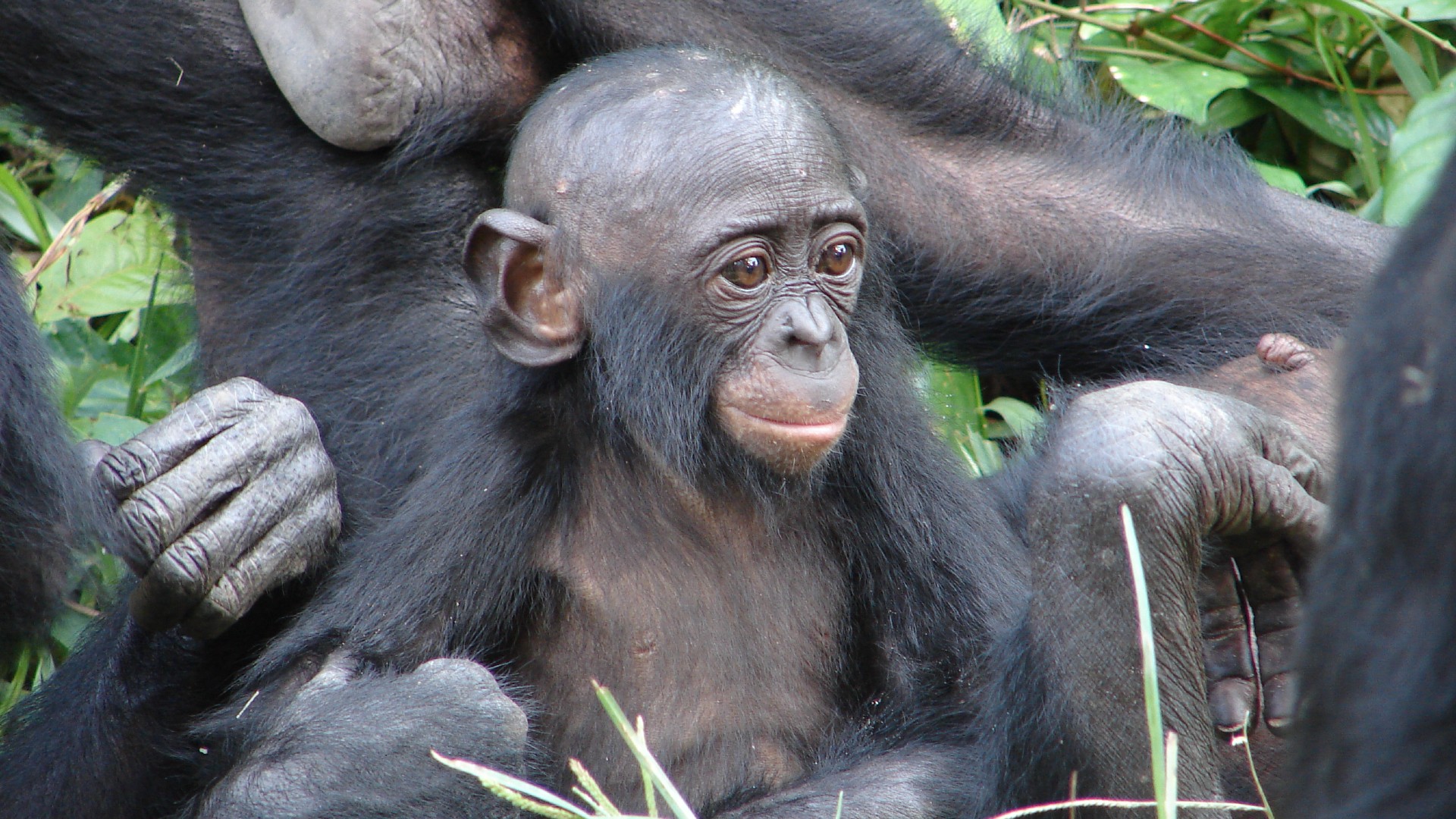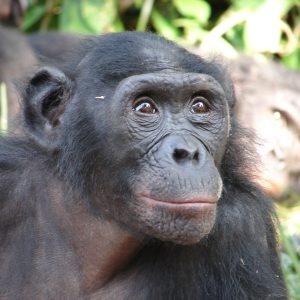How we protect bonobos
Born Free’s Head of Conservation Dr Nikki Tagg highlights the mystery and uniqueness of bonobos and reports on what Born Free is doing to protect these rare great apes, in this fascinating long-read.

Infant bonobo at Lola ya Bonobo (c) Nikki Tagg
Born Free has supported great ape conservation for many years, helping promote human-chimpanzee coexistence in Uganda and orangutan protection and rehabilitation in Borneo. In 2022, we launched the Guardians of Dja: our very own, brand-new chimpanzee and gorilla conservation programme in Cameroon, offering training to forest-dwelling communities to generate a sustainable and reliable income that does not rely on consumptive use of wildlife.

Dr Nikki Tagg, Head of Conservation
Alongside chimpanzees and gorillas, there is another great ape species living on the African continent, perhaps the most mysterious and unique of them all: bonobos. Chimpanzees and bonobos are the only two species making up the genus Pan. Chimpanzees (Pan troglodytes) comprise four different subspecies across their range (troglodytes, verus, schweinfurthii and ellioti), whereas bonobos (Pan paniscus) are not divided into subspecies. Bonobos are endemic (only live in one country or area) to the forests of Democratic Republic of Congo (DRC), south of the Congo River, compared to chimpanzees whose range spans 12 countries across East, Central and West Africa.
For a long time, it was assumed chimpanzees and bonobos were of the same species, until 1929 when it was discovered that in fact bonobos and chimpanzees are distinct species that separated from each other about 1.8 million years ago. Scientists have hypothesised that the massive Congo River formed a physical barrier, which isolated populations of the chimpanzee-bonobo ancestor, and, over hundreds of thousands of years, led to the ‘differential speciation’ of chimpanzees and bonobos (they became distinct species).
Interestingly, although the physical differences between humans and great apes may seem more marked, chimpanzees and bonobos are genetically more closely related to us (sharing 98.7% of human DNA) than they are to gorillas. Even so, these few percent are hugely significant – the human and the chimpanzee-bonobo ancestors separated from our common ancestor over six million years ago.
So, what became of the chimpanzee-bonobo lineage? Bonobos and chimpanzees are quite similar in appearance, but bonobos are of a more slender build – they were formally known as ‘pygmy’ or ‘dwarf’ chimpanzees – typically have pink lips and eyelids, and the species exhibits less of a difference in size and stature between males and females than is evident in chimpanzees. Furthermore, while chimpanzees hoot, scream and grunt, bonobos tend to peep and yelp.

Mother and infant (c) ABC
However, the most interesting differences between bonobos and chimpanzees are evident in the bonds that hold them together. Bonobo society is female-dominant – the only great ape species to exhibit this characteristic – with females forming tight bonds with each other and with their sons. In contrast, female-female bonds in chimpanzee societies are typically weak, where groups are led by an alpha male.
Another unique trait of bonobo society is their frequent use of non-reproductive sexual behaviour at any age and with any partner, including same-sex and between juveniles and adults. Non-reproductive sexual behaviour is rarely observed among chimpanzees, where high-ranking males monopolise and guard females in oestrous. This unique female-led bonobo society that uses sex to both solve conflicts and deepen relationships with each other encourages cooperation, coexistence, and peace.
And evidence suggests that it works. Bonobos have not been observed in the wild to attack neighbouring groups; instead, mating across community lines has occasionally been observed. Chimpanzees, by contrast, are infamously aggressive, with fierce protection of territory boundaries sometimes resulting in lethal aggression.
As well as being fascinating, bonobos are also incredibly important. Bonobos play a crucial role in maintaining a healthy ecosystem within their rainforest habitat. Because they feed on fruit and vegetation, they distribute seeds and nutrients around the forest.
Sadly, bonobos are losing their forest home and the bonobo population has significantly declined in the last 10 to 20 years. They have been classified on the IUCN Red List as Endangered since 1996 and as few as 15-20,000 individual bonobos remain. This figure is estimated from four strongholds within DRC (Maringa-Lopori-Wamba, Tshuapa-Lomami-Lualaba, Solong, and Lac Tumba-Lac Mai Ndombe), but accurate population estimates are not available because only 30% of the bonobos’ historic range has been surveyed due to civil unrest, inaccessibility of much of their range, and a patchy distribution.

Bonobos at Lolo ya Bonobo (c) Nikki Tagg
The ongoing decline of the species is predominantly due to bushmeat hunting. Bonobos have a slow life history, with females giving birth to a single infant only every five to six years, as they tend to nurse and carry their babies for this length of time, and a generation time estimated to be 25 years, so populations cannot withstand high levels of loss. They are also being threatened by habitat destruction – only a small portion of their habitat is protected so slash-and-burn agriculture is widespread and is a huge problem in the DRC, but industrial agriculture could become a serious threat over the coming years. All these factors pose challenges to their conservation.
In response, Born Free has pledged funding, through the McKenna-Travers Award, to Fanny Minesi, Executive Director of Friends of Bonobos. Founded by Fanny’s mother, Claudine André, Friends of Bonobos’ mission is to save the bonobos from extinction and preserve their habitat. To do so, they run the only bonobo rehabilitation centre and sanctuary in the world, named Lola ya Bonobo (‘Heaven for Bonobos’), where orphaned bonobos, victims of illegal bushmeat trafficking, can be rescued, rehabilitated and cared for, and if possible, released back into the wild.
In the coming year, the funds awarded by Born Free through the McKenna-Travers Award will directly support the Friends of Bonobos’ work to provide rescued bonobos a chance to fully recover their innate capacities such that they may be returned to live in their rightful wild habitat. Specifically, the funding will enable an expansion of the Nursery Playground, the construction of two additional play structures, and the replacement of the heavy-duty ropes, which are currently getting worn out. The playground is a pivotal feature in the orphaned bonobos’ rehabilitation, benefitting their social, emotional, and physical development that will be key to the likelihood and success of their reintroduction back into the wild.
We are excited to see how this project develops this coming year. Look out for updates on our website!
